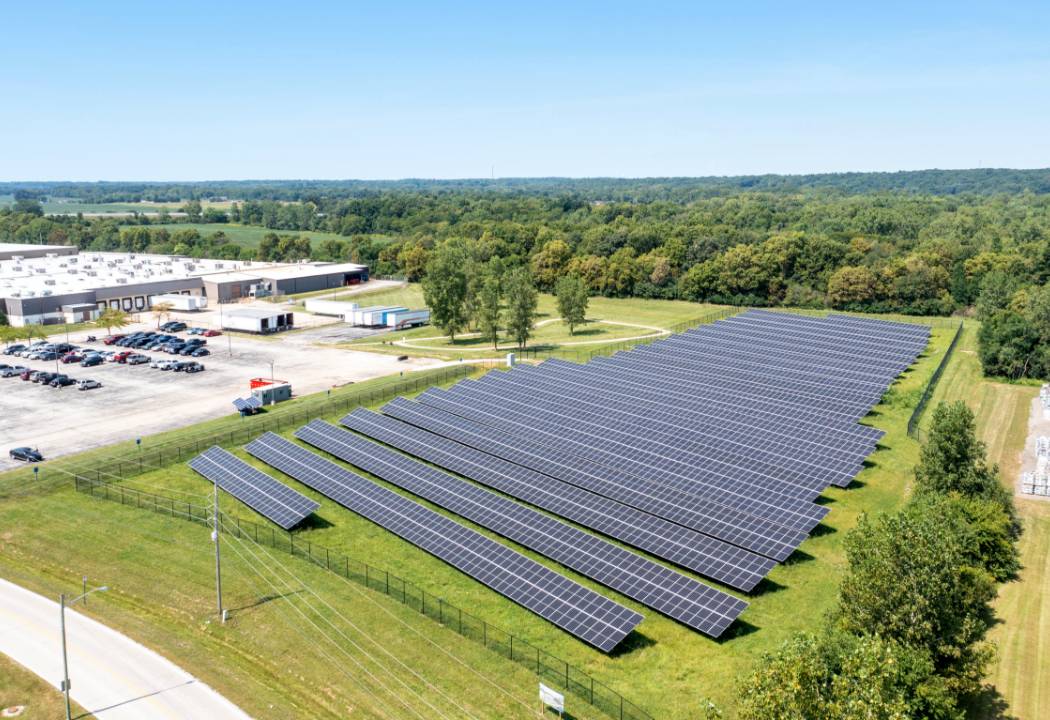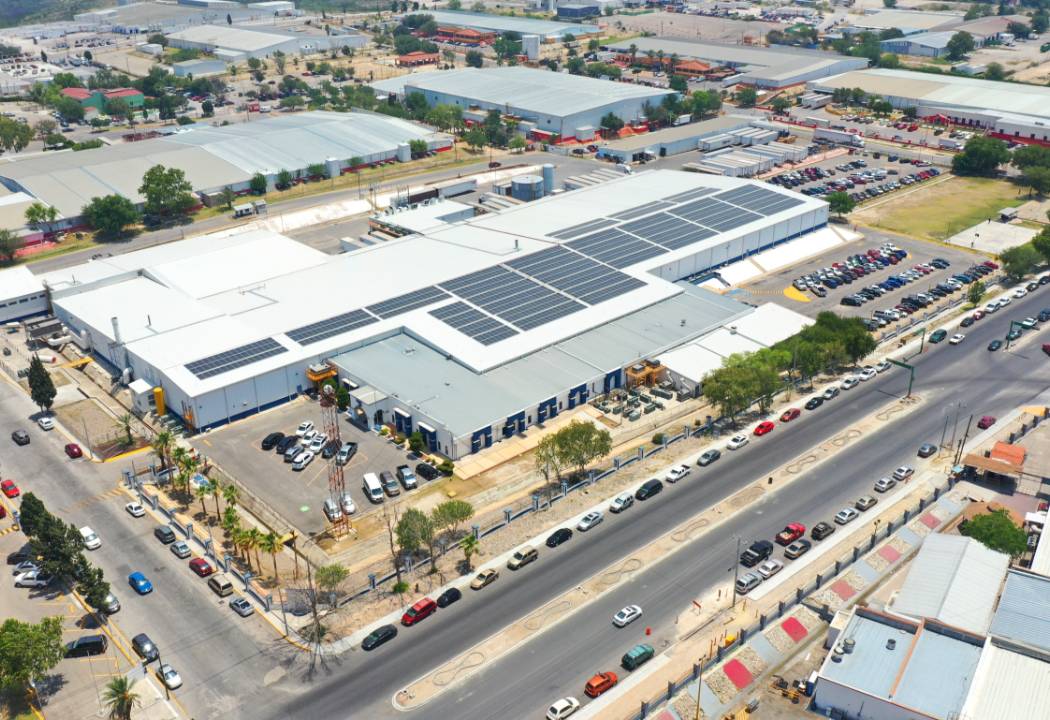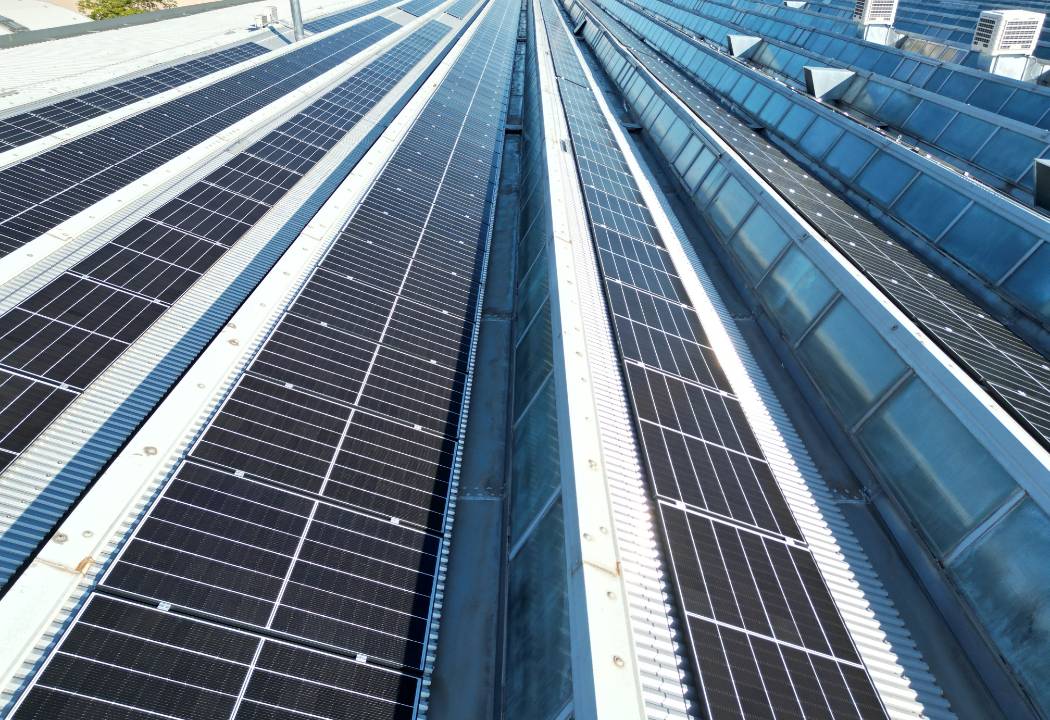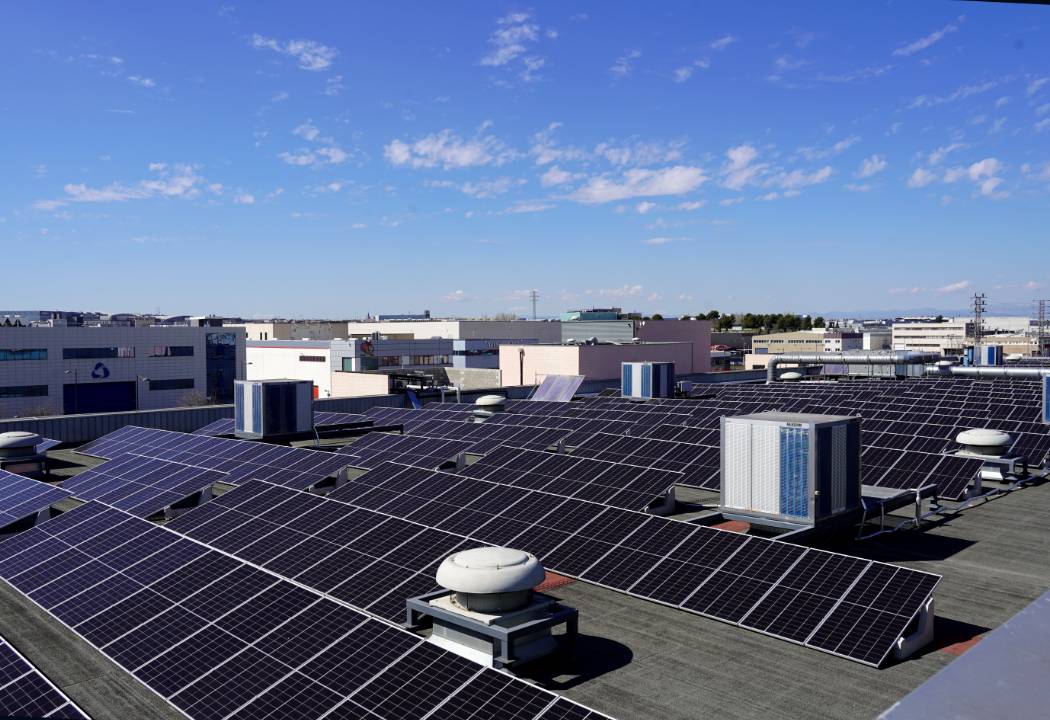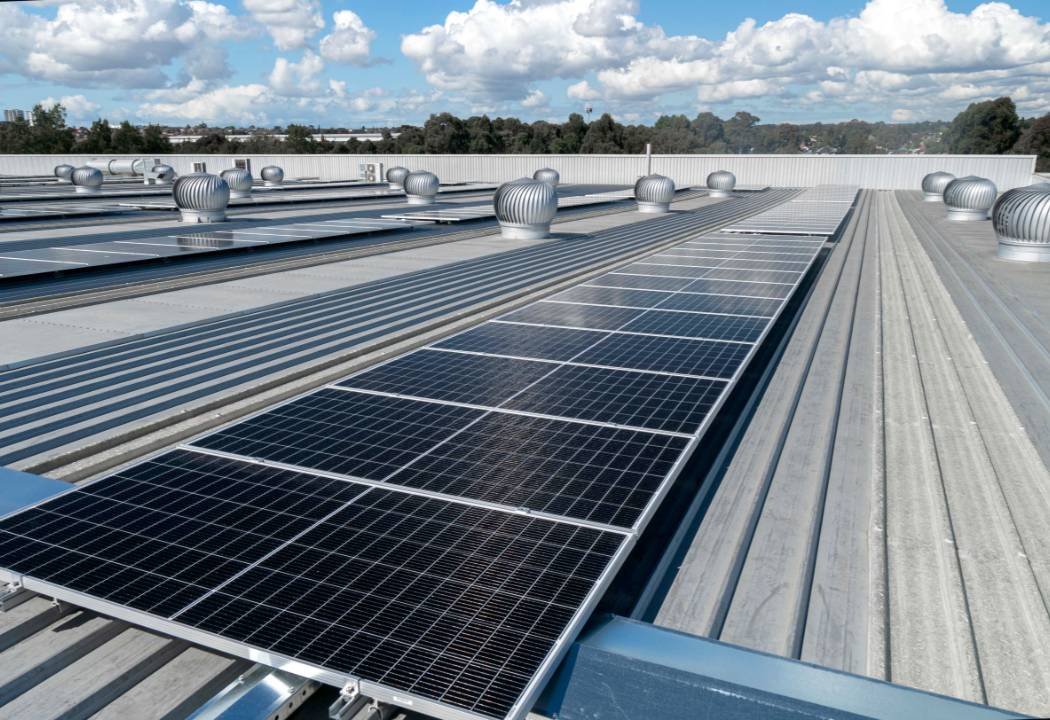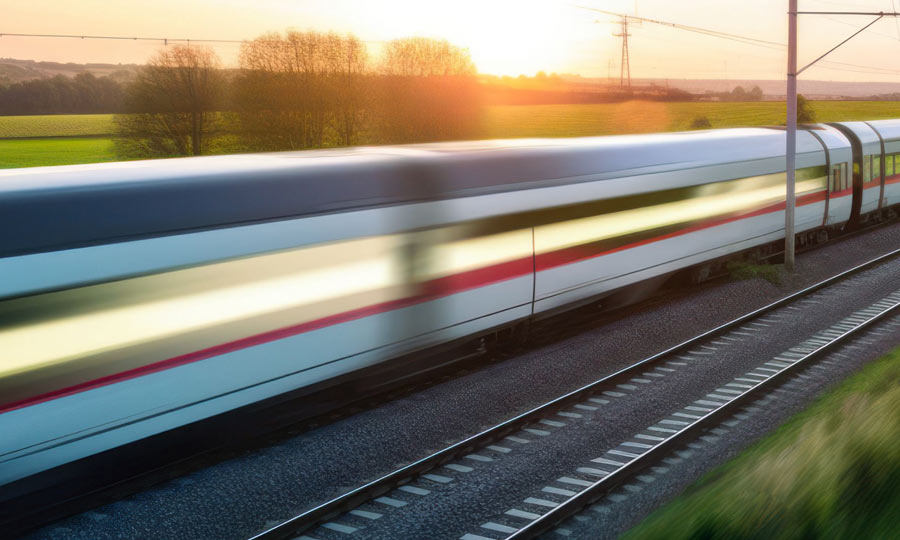Environment
Resource consumption and climate change are major challenges for business and society. Our Climate Strategy 2030 is designed to significantly reduce energy consumption and carbon emissions at our own production sites. The Knorr-Bremse EcoDesign approach helps us to ensure that material sustainability aspects of our products can be taken into account across the entire life cycle. In use, our products facilitate the safe, efficient and sustainable mobility of rail and commercial vehicles.
Environmental Management
By practicing holistic environmental management, we seek to continuously reduce the environmental impact of our business activities. Clear processes and local measures promote the conservation of resources as well as the reduction of emissions and waste at Knorr-Bremse.
The company’s Health, Safety and Environment (HSE) Policy defines the principles of environmental and climate protection and energy management in the Knorr-Bremse Group. We want to prevent or minimize potential impacts that our processes, services or products could possibly have on people and the environment. To implement these measures, we have introduced divisional HSE management systems using standardized processes at our sites around the world. The HSE management systems are an integral part of our company management systems (Rail Excellence [REX] at RVS and Truck Excellence [TEX] at CVS). They are based on legal regulations, customer requirements, internal policies and process instructions. In addition, our processes are guided by national and international standards such as ISO 9001, ISO/TS 22163, IATF 16949 (quality management), ISO 14001 (environmental management), ISO 45001 (occupational safety) and ISO 50001 (energy management). Knorr-Bremse conducts regular internal and external audits to monitor its environmental management, auditing compliance with specified standards and the implementation of defined improvement measures.
We require selected locations to be certified in accordance with the environmental management standard ISO 14001. When implementing energy management, we follow the European Energy Efficiency Directive and have had all our European production sites certified in accordance with ISO 50001 or had energy audits conducted in accordance with EN 16247. In addition, largely energy-intensive sites in Brazil, India and the United States are also certified.
Number of audited/certified business units with environmental management systems
| 2022 | 2021 | 2020 | |
|---|---|---|---|
| Based on environmental management standard ISO 14001 | 71 | 70 | 67 |
| Based on energy management standard ISO 50001/EN 16247 | 37 | 38 | 36 |
The central HSE departments of the RVS and CVS divisions are responsible for managing and implementing environmental management. They develop strategic guidelines and bring together all cross-site management and coordination duties. Knorr-Bremse’s senior management is involved in strategic and operational environmental management through regular meetings, ad hoc reporting or via the ESG Board. HSE managers implement the strategic requirements, goals and programs at the Knorr-Bremse sites with the local managers. Local environmental protection and energy officers, regional coordinators and experts from the departments involved provide support. We strive to have largely uniform HSE management across both divisions. There is a regular exchange of expertise both within and between the divisions to this end. This addresses aspects relevant to HSE, best practices, legal requirements and the associated reporting.
Climate Protection
Knorr-Bremse has set itself the objective of making mobility more sustainable. Climate protection and reductions of carbon emissions are two key goals in this effort. With our Climate Strategy 2030, we want to make our contribution to the goals of the 2015 UN Paris Agreement to limit global warming to a maximum of 1.5 degrees.
In a first step, we are focusing on reducing emissions that arise as a result of energy use by Knorr-Bremse’s production sites and vehicle fleet (Scope 1 and market-based indirect Scope 2 emissions). In 2019, the company set a goal of reducing production-related carbon emissions by at least 50.4% by 2030. This equates to an average CO2 reduction of 4.2% annually compared to 2018. This is to be achieved through the following levers:
In a second step, we extended Knorr-Bremse’s climate goals to the value chain at the beginning of 2023 and set an ambitious reduction target: We intend to reduce emissions of the upstream and downstream value chain (Scope 3) that are related to our business activities by 25% by 2030 compared to the base year of 2021. We focus in particular on emissions from the Scope 3 categories 3.1 Purchased Good and Services, 3.4 Upstream Transportation and Distribution and 3.11 Use of Sold Products. We conducted a detailed analysis of these three emission categories to identify the steps of the value chain that cause the largest amount of carbon emissions. As a result of this analysis, we were able to determine the biggest emission drivers during the reporting period and identify clear areas of action based on these findings. Increased transparency is essential for us to make our targeted improvements. With this thought in mind, we continuously work on refining our data collection methodology.
As another contribution to climate protection, Knorr-Bremse has committed itself to carbon neutrality at its sites from 2021. To this end, we offset Scope 1 and Scope 2 emissions still remaining after our own measures by investing in selected climate protection projects during the last reporting period (2021). Due to changed framework conditions for emission offsetting1, the emission reductions achieved in climate protection projects are currently counted toward the country-specific climate goals of the project host countries. Accordingly, we will make a contribution to the reduction targets of the respective project countries in the future2. This is because our commitment to climate protection remains unchanged. We will continue to finance selected climate protection projects to prevent global emissions at least by the amount of our remaining Scope 1 and Scope 2 emissions of approximately 50,000 metric tons of CO2 in the year under review. To this end, we finance two atmosfair gGmbH climate protection projects certified in accordance with the Gold Standard: the project for clean drinking water in Kenya and the project for efficient wood gasifier ovens in India.
key Scope 3 emissions
by 25% by 2030.
Financial Support for Climate Protection Projects in Kenya and India
As another contribution to climate protection, Knorr-Bremse acts jointly with atmosfair gGmbH, Berlin, to fund climate protection projects that are at least equal to the amount of Scope 1 and Scope 2 emissions remaining during the reporting period. To this end, we finance two atmosfair gGmbH climate protection projects certified in accordance with the Gold Standard: the project for clean drinking water in Kenya and the project for efficient wood gasifier ovens in India. These projects were selected together with Knorr-Bremse Global Care e.V.
In 2022, global emissions were lowered by about 50,000 metric tons with the help of a project called “Efficient Wood Gasifier Ovens” in India. With the assistance of the local project partner Sapient, based in Kolkata, low-income households in rural parts of West Bengal are given efficient wood gasifier ovens that use 50% to 60% less firewood. The ovens enable smoke-free cooking, while the gasification process also produces charcoal that can be sold. The reduced use of wood also protects the mangrove forests in West Bengal. A total of 30,000 new ovens subsidized by Knorr-Bremse are planned to be distributed by 2030.
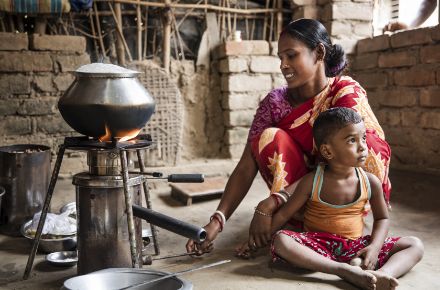
The project “Clean Drinking Water”, run by the local project partners Boreal Light GmbH and Waterkiosk Ltd., helps to provide access to clean drinking water for rural households in Kenya. This improvement will help prevent water-borne illnesses.
Up to 20,000 liters of water are desalinated and cleaned by the first solar-powered water treatment plant in Burani, Kenya. The result is clean drinking water for 6,000 people, and the unit also produces process water. The certification of the project was completed in late 2022. There are now 31 units in operation. Alongside the monitoring of the carbon emissions prevented by the project, a study is being conducted in collaboration with Knorr-Bremse Global Care e.V. to identify the positive health effects enjoyed by the local population.
Climate Strategy 2030 Interim Targets Achieved
We achieved our climate protection targets in the reporting period: We reduced our Scope 1 and market-based Scope 2 emissions by 69% in 2022 compared to the base year 20181 . In doing so, we again exceeded our goal of lowering our carbon emissions each year by an average of 4.2%. Our increased purchase of green power has been our most important lever and contribution thus far. At the same time, we are strengthening our measures in the areas of energy efficiency and self-generation of renewable energies.
Energy and Carbon Footprint at Knorr-Bremse
Knorr-Bremse recorded total energy consumption of 524 GWh in 2022. This is equivalent to an approximately 22% increase compared to the previous year. This increase resulted largely from the consolidation of the past M&A activities relating to our subsidiaries R.H. Sheppard in the United States, Knorr-Bremse Steering Systems in Japan and EVAC in Germany. If the system parameters of previous reporting periods were applied, a decline in total energy consumption would have been recorded. About 64% of total energy usage was attributed to electricity and 26% to natural gas in 2022. The share of power generated by renewable energy sources totaled 94% in 2022 (2021: 98%), with 0.7% of this being self-generated (2021: 0.6%).
Energy Consumption1
| 2022 | 2021 | 2020 | 20185 | ||
|---|---|---|---|---|---|
| Primary energy consumption | GWh | 180 | 131 | 119 | 159 |
| Natural gas | GWh | 138 | 99 | 91 | 126 |
| Fuels | GWh | 39 | 31 | 26 | 33 |
| Self-generated renewable energy2 | GWh | 2 | 1 | 1 | 0 |
Secondary energy consumption |
GWh |
344 |
301 |
287 |
349 |
| Purchased electricity2 | GWh | 336 | 287 | 273 | 338 |
| Of which renewable energy3 | % | 94 | 98 | 86 | 12 |
| District heating | GWh | 8 | 14 | 13 | 11 |
Total energy consumption4 |
Gwh |
524 |
431 |
406 |
508 |
| Energy efficiency | MWh/€ millions of revenue |
73.3 | 64.3 | 65.9 | 76.9 |
In line with our increased energy consumption, our absolute Scope 1 and market-based Scope 2 emissions in 2022 increased by approximately 15,000 metric tons of CO2 compared to 2021. The intensity of carbon emissions (Scopes 1 and 2) totaled 7.0 metric tons of CO2 emissions per million euros of revenue in the year under review (2021: 5.2 metric tons). The use of natural gas by Knorr-Bremse was the primary source of 38,000 metric tons of Scope 1 emissions that were produced in 2022 (2021: 28,000 metric tons). Indirect carbon emissions (Scope 2, location based) totaled 122,000 metric tons of CO2 (2021: 152,000 metric tons). These emissions are largely composed of purchased electricity in particular.
Direct and Indirect Carbon Emissions1
| 2022 | 2021 | 2020 | 20182 | ||
|---|---|---|---|---|---|
| Scope 1 direct carbon emissions | Thousands metric tons of CO2 | 38 | 28 | 26 | 34 |
| Scope 2 indirect market-based carbon emissions | Thousands metric tons of CO2 | 12 | 7 | 27 | 127 |
| Scope 2 indirect location-based carbon emissions | Thousands metric tons of CO2 | 122 | 152 | 147 | 151 |
| Total market-based carbon emissions | Thousands metric tons of CO2 | 50 | 35 | 53 | 161 |
| Total location-based carbon emissions | Thousands metric tons of CO2 | 160 | 180 | 173 | 186 |
| Carbon intensity | Metric tons of CO2/€ million | 7.0 | 5.2 | 8.6 | 24.4 |
In the year under review, Knorr-Bremse moved forward with its work to expand its monitoring of upstream and downstream emissions (Scope 3). The focus of this effort was placed on those emission categories that are relevant to Knorr-Bremse: Scope 3.4 (Upstream transport and distribution), 3.9 (Downstream transportation and distribution) and Scope 3.11 (Use of sold products). The emission categories Scope 3.1 (Purchased Goods and Services), Scope 3.3 (Fuel- and Energy-Related Activities), Scope 3.6 (Business Travel) and Scope 3.7 (Employee Commuting) were calculated during the reporting period.
Carbon Emissions in the Value Chain (Scope 3)1
Thousands metric tons of CO2e
| 20222 | 2021 | |
|---|---|---|
| 3.1 Purchased goods and services | 1,802 | 1,8554 |
| 3.3 Fuel- and energy-related activities | 45 | 535 |
| 3.4 Upstream transportation and distribution3 | 184 | 191 |
| 3.6 Business travel | 6 | 4 |
| 3.7 Employee commuting | 25 | 266 |
| 3.9 Downstream transportation and distribution3 | 47 | 50 |
| 3.11 Use of sold products 3 | 26,301 | 27,736 |
Climate Protection Measures at Sites
The Knorr-Bremse Climate Strategy 2030 is implemented with the divisional HSE managers and with representatives of the Americas and Asia regions, the Sustainability department and Energy Purchasing. Local environmental and energy management has the task of evaluating and improving processes in the Group on an ongoing basis with respect to energy requirements. For example, consumption data can be monitored at sites, savings potential can be found and the efficiency of any measures implemented can be audited. You can find out here how we achieved our climate targets for 2022 with the help of three levers:
New Photovoltaic Systems Produce Electricity for Production Sites
Conservation of Resources
Knorr-Bremse wants to reduce the use of raw materials, consumables and supplies and, as far as possible, recycle them. This concept of reducing use and the circular economy applies to all waste as well as water. In principle, our waste management practices are designed to avoid waste – be it raw materials generated during production, packaging or other waste on-site. At the same time, we strive toward the sustainable use of water and, in doing so, account for the different requirements and needs of our locations around the world.
Global Waste Management
For its waste management, Knorr-Bremse is guided by the principle of a sustainable circular economy. Waste prevention is the top priority. If waste cannot be avoided, we strive to recycle it in an environmentally friendly manner. In essence, Knorr-Bremse’s global waste management is based on three principles:
- Avoiding waste through the systematic and optimized use of resources
- Substituting materials with more environmentally friendly substances, for example avoiding the use of single-use plastics
- Promoting a circular economy based on environmentally friendly recycling and reusing materials
Waste at Knorr-Bremse primarily consists of scrap metal, paper and residual waste. As a manufacturing company, Knorr-Bremse generates waste containing steel and iron materials, lightweight metal, polymers, supplies and packaging. In addition, the surface treatment of metallic materials produces galvanic sludge.
The Knorr-Bremse Production System (KPS) helps the company to reduce the amount of waste generated in production. Value stream mapping is used to uncover and eliminate various types of waste, such as overproduction or substandard products. Knorr-Bremse itself tries to avoid or reduce packaging to the greatest extent possible and to use recyclable materials and containers. Our quality guidelines urge our suppliers to use the same practices.
Global Water Management
We aspire to use water as efficiently as possible and to reuse it as many times as possible in a recirculation system. In particular, Knorr-Bremse uses water for the surface treatment and cleaning of its products, for test applications as well as for drinking and sanitary purposes. The usage of water varies strongly by location. We obtain our water from public utilities. As a way of conserving drinking water, some of our business locations use rainwater for cleaning purposes, sanitary facilities and green space irrigation. We dispose wastewater via public wastewater systems.
Environmental Product Design
Knorr-Bremse can make a contribution to climate and environmental protection with systematically environmentally oriented product development, while also achieving a medium- and long-term competitive edge. Knorr-Bremse EcoDesign – environmental product design – enables us to develop products, processes and services with an improved environmental impact across the complete product life cycle. In this way, we want to ensure a future-proof product portfolio and, at the same time, pursue our corporate vision and HSE Policy. With the EcoDesign approach, in addition to various internal requirements, the requirements of regulatory stipulations, standards and customer expectations also influence product development. The focus here is on sustainability aspects such as a long service life, resource conservation and avoiding emissions.
EcoDesign Integrated into the Organization
EcoDesign is organizationally incorporated into both divisions in such a way that it supports strategic R & D planning and creates synergies and standardized processes between the Group divisions. The EcoDesign experts of the RVS and CVS divisions have one central function here. They are integrated into the development processes and help, for example, with the assessment of product development. They are supported in this work by divisional analysis teams that analyze Knorr-Bremse products and components with regard to compliance with internal, legal and customer requirements on contents. The EcoDesign experts also form the cross-divisional EcoDesign working group with representatives of the Sustainability department and, where required, the Remanufacturing department. In regular dialog, they develop, among other things, standards for product development and processes for the product life cycle. In the year under review, the focus was mainly on recording the Scope 3 emissions in product use and identifying reduction potential.
Intensive training of engineers and developers in the past few years has given them a shared understanding of EcoDesign standards for evaluating product development. We continue to offer this training on an ongoing basis. In 2022, we focused on specialized departmental training. As part of this program, the new EcoDesign analytics team in the RVS division was trained on the self-developed EcoApp. The app can be used to transfer analytical results on the contents of components into an internal database and customer formats using a digital workflow.
EcoDesign in the value chain
EcoDesign in Development Processes
Knorr-Bremse wants to proactively integrate EcoDesign aspects into product development and is working on systematically integrating sustainability criteria into the processes – from strategic planning through innovation to product development.
Product Development: Analysis and tools for minimized environmental impact
In the RVS division, the EcoDesign assessment form is provided to the development teams for the mandatory assessment of innovation projects and complex customer projects. It defines the requirements for product design and makes assessment tools available, such as supporting standards and methods for evaluating environmental impacts. For example, the recyclability analysis of the materials used helps us to identify and reduce their potential environmental impact. In 2022, a total of 21 projects in the RVS division were reviewed on the basis of a recyclability analysis in accordance with ISO 22628 and/or ISO 21106. Here, the result of the rail vehicle business area’s products is in average more than 90% recyclability for Knorr-Bremse products. RVS also conducted four life cycle assessments (LCAs) of new developments compared to their reference system in 2022. These assess the environmental impact of Knorr-Bremse products and systems, and in this context on climate change in particular. The analyses deliver valuable insights on the use of materials and energy in production and impacts in the product usage phase through to disposal. The LCAs were conducted in accordance with standards such as ISO 14040 and the UNIFE Product Category Rules, and their findings were presented to the leading trade fair InnoTrans in 2022.
The CVS division has defined concrete EcoDesign requirements and targets in the product development and commercialization (PDC) process for new products and products with significant changes. These requirements and targets – for example, a minimum reduction in weight – need to be implemented in the phases of project planning through to the product and process development. In this process, specific guidelines and concrete tools and methods provide support. These include the IMDS system for identifying hazardous materials and materials requiring declaration, comparative analyses of material-specific environmental impacts and the EcoDesign assessment form.
Life cycle analyses: environmental impacts of selected Knorr-Bremse products (RVS)
Conservation of Resources through Industrial Remanufacturing
Our RailServices and TruckServices business is another driver of sustainable product design. This activity focuses on, among other tasks, remanufacturing in the CVS division and overhaul in the RVS division, which are significant lines of business. In this work, Knorr-Bremse industrially remanufactures products so that they can perform an identical function in the transportation industry once again. The longer product life cycle also reduces the amount of material used and saves energy, two improvements that have a positive impact on our life cycle assessment and the life cycle assessment of our customers.
We are able to extend the useful lives of our products by incorporating remanufacturing and overhaul into the development and construction process. Rail vehicle customers who turn to one of Knorr-Bremse’s 50 service centers around the world can have these vehicles overhauled and repaired. Components can be regularly reconditioned here and used once again in a particular fleet or vehicle following a successful test. The goal is to maintain a component’s functionality until the end of a particular train’s service life. One example is compressors that are reconditioned after they have been used for defined periods of time or operating hours. The replacement of a component or the installation of an additional function can also be done as part of a complete upgrade or modernization project. This complete overhaul can extend the useful life of an entire train.
In 2022, Knorr-Bremse’s service center in Berlin remanufactured about 63,600 products used for the widest range of jobs. In China, the brake systems for more than 4,400 cars for high-speed trains, 1,900 locomotives and nearly 3,200 product units for metro trains were remanufactured in 2022. In addition, about 3,200 entrance systems and 1,100 air-conditioning units for high-speed and metro trains were remanufactured.
The portfolio of the CVS division in the region Africa/Europe comprises remanufactured products with about 1,000 product numbers. The portfolio is available under the brand name EconX®. In the year under review, 2,045 tons of CO2, 736 tons of material and 8,750 MWh of energy were saved as a result of industrial remanufacturing.
Eco-Friendly Logistics
Knorr-Bremse strives for eco-friendly logistics throughout its entire value chain. We continuously optimize our operational transport management, including with the support of external service providers. These contractors assume responsibility for the planning, consolidation and operational execution of deliveries from external suppliers to Knorr-Bremse, goods transportation between Knorr-Bremse sites and deliveries to our customers.
We strive to minimize both costs and the environmental impact of product transportation. We also continuously optimize our coordinated usage of rail, road and shipping connections. We achieve this through the use of standardized processes and methods, which, at the same time, increase our service quality across all distribution channels with regard to delivery reliability, delivery quality and delivery deadlines. In 2022, we continued to primarily use ships for most of our intercontinental product transportation. Our target utilization rate of at least 85% for sea freight containers (CVS) supports efficient goods transportation. Rail transportation to China, an option that was increasingly used during the regional Covid-19 restrictions imposed in the country, had to be temporarily halted as a result of the war in Ukraine. They were partially resumed to toward the end of 2022. We avoid air freight transport whenever possible.
We are also working to reduce the carbon footprint of our global transportation network. As part of our efforts, we measured the carbon footprint of this global network for the first time (Climate Protection). Both divisions will increasingly consider the carbon emissions from transportation as a decision-making criterion for optimizing logistics. The Commercial Vehicle Systems (CVS) division plans to introduce a transport management system (TMS) to evaluate and monitor the impact of carbon reduction measures. CVS is already quantifying and evaluating the transport-related carbon emissions when there are new sourcing activities. A further monetary evaluation will serve as a financial incentive to reduce carbon emissions, in addition to the transparency that is created.
Knorr-Bremse continuously monitors and analyzes transportation flows in conjunction with its logistics contractors. This work enables shipments to be consolidated and carbon emissions to be reduced. It has also resulted in the creation of local projects like the restructuring of internal goods transportation in the Munich region.
Smart Logistics in Munich
In Munich, Knorr-Bremse works with a strategic logistics partner, which benefits the efficiency of processes and communications. One specific example of this is the new e-truck that has been helping internal logistics operations in Munich since 2022. It travels between the company’s warehouse in Garching and Knorr-Bremse’s sites in Munich. On an annualized basis, the e-truck covers a distance equivalent to a mini-world tour – a journey that is now carbon neutral.
Another emission-lowering measure completed during the reporting period was a project called the NextGen European Distribution Network. The revised European distribution structure near our sites in Spain, Hungary and Germany will improve the efficiency of transportation flows and lower their emissions. This successfully implemented project received the Supply Chain Management Award 2022 in Germany.
The CVS division is reducing its carrier portfolio in the Europe/Africa region by increasingly focusing on strategic partnerships. Another step being taken to enable more efficient carbon emissions management involves reducing the number of interfaces with freight-forwarding companies. We will work on similar steps in the Asia/Pacific region and South America in the future.
The CVS division has introduced a central tracking process for the Europe/Africa region to optimize the logistics of special freight shipments around the world. Completed and scheduled special freight shipments are analyzed in a regional process for sales inventory operations planning (SIOP). The results will be used to define countermeasures such as increases in inventories on a cyclical basis.
